Dec. 16, 2012
Feb. 21, 2014, Minor updates
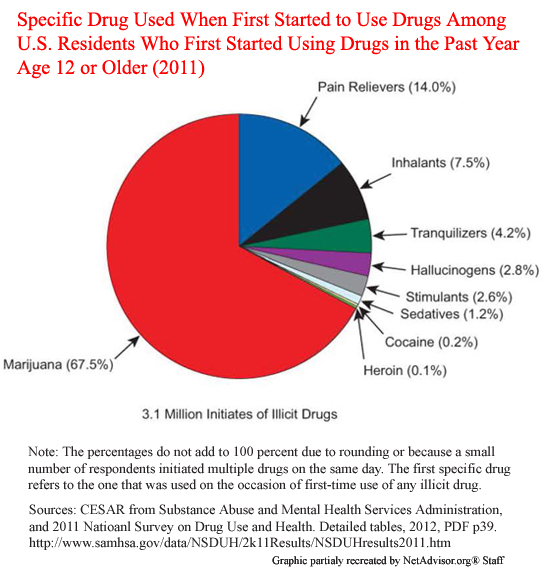
Analysis: Drug Legalization Policies in the U.S. and Mexico
original article written by Net Advisor™
[1] USA & MEXICO. There has been an apparent increasing movement to push for legalizing controlled substances (drugs) in the United States. With a simple majority, two states, Washington and Colorado legalized marijuana for “personal use” during the November 2012 General Election.
I would argue this is just the beginning of the drug legalization movement. Proponents have argued since we are losing the “War on Drugs” that we should just legalize it.
After reading various websites that attempt to rationalize behavior for their drug use, the data by experts those who are not on drugs don’t seem to support the irrational thinking.
[2] Marijuana is a Gateway Drug
A 2011 report found that those who use or have tried illegal drugs began with marijuana.
“An estimated 3.1 million persons ages 12 or older—an average of approximately 8,400 per day — used a drug other than alcohol for the first time in the past year, according to data from the 2011 National Survey on Drug Use and Health. More than two-thirds (68%) of these new users reported that marijuana was the first drug they tried.”
— Center of Substance Abuse Research (CESAR), 10-22-2012, Volume 21, Issue 42 (1 page PDF)
See the full 2011 Report, U.S. Dept. Health and Human Services (103pps) (link only)(PDF)
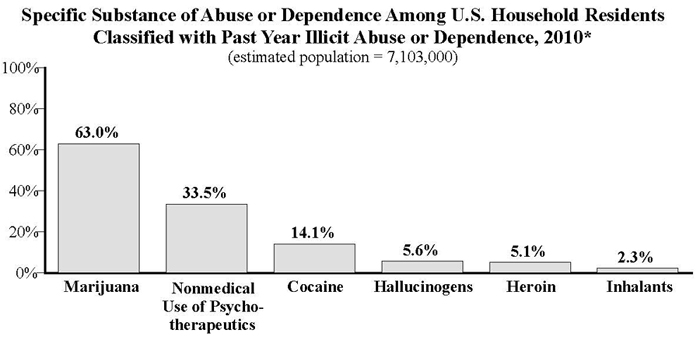
[3] U.S. Illegal Drug Use Highest Level in Nearly a Decade
In 2010, the U.S. government released a report that said illegal drug use hit its highest level in nearly a decade.
“The rate of illegal drug use rose last year to the highest level in nearly a decade, fueled by a sharp increase in marijuana use and a surge in ecstasy and methamphetamine abuse…”
— Source: CBS News, 09-16-2010 (PDF)
Proponents argue (story link gone) that marijuana is “not addictive.” A recent report from the U.S. Department of Health and Human Services, Substance Abuse and Mental Health Services Administration (SAMHSA) found otherwise. The above chart shows that there are 7.103 million people in the USA who meet the definition for “Illicit Abuse” or “Dependence” on illegal drugs.
According to the U.S. government report, the #1 most abused or dependent drug in the USA: Marijuana. Sixty-three percent of those who use illicit drugs and classified as dependent, use marijuana (Source: CESAR report 09-03-2012, Vol 21, Issue 35, PDF share link).
https://youtu.be/ZrZ25jvcacA
[4] Follow the “Leader?” Obama Admitted to Heavy Alcohol and Drug Use
Mr. Obama admitted in his book Dreams From My Father, that he spent his last two years of high school “in a daze,” drinking heavily and actively engaging in the use of illegal controlled substances (drugs).
“I attended classes sparingly, drank beer heavily, and tried drugs enthusiastically.”
— President Barack Obama, said in his book Dreams From My Father (video above)
How does one spend the last half (2 years) of high school “in a daze” rarely attending class, “drinking heavily” and doing “drugs enthusiastically” and somehow then get into college, then Columbia and Harvard with what kind of grades is something quite impressive.
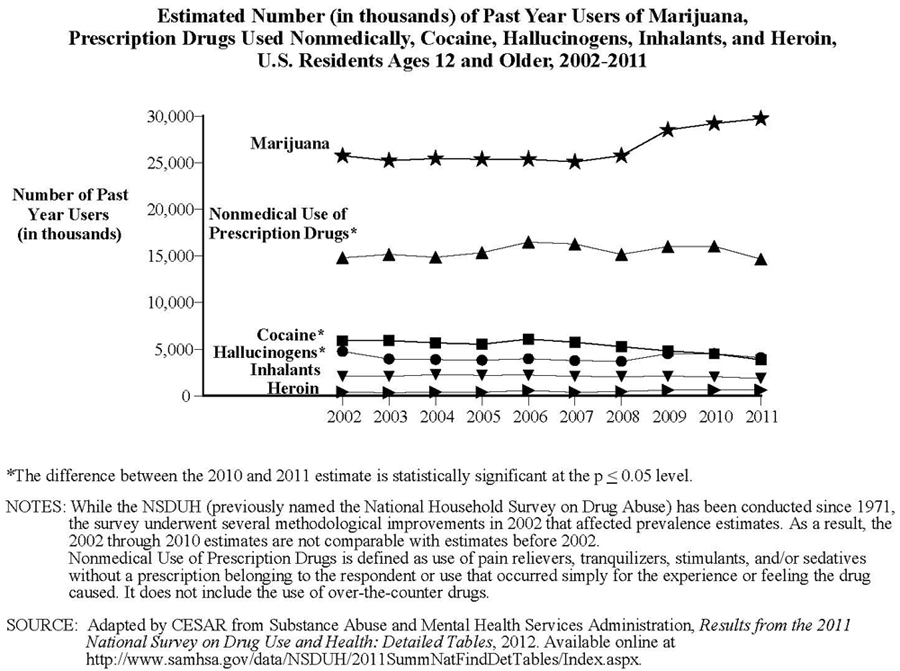
[5] Marijuana Drug Users Increased Since Obama Presidency
Marijuana is the most commonly used illicit drug among U.S. residents. What is interesting is that Marijuana use was on the decline from 2002 to 2008 during the Bush Administration. However, this coincidentally changed in late 2008 when President Obama won the office of the Presidency. The graphic above suggests marijuana use in the USA has been on the rise ever since Obama has been in office (Report, 1 page PDF).
[6] Health Risks & Toxicology Testing for Suicide Victims
On March 24, 1982 the U.S. Surgeon General published and official health advisory (warning) on marijuana use and known or suspected chronic effects.
The Centers for Disease Control (CDC) conducted several studies analyzing suicides in 13 states by using Toxicology testing.
The CDC published a study in 2006 that found there was an estimated 31,484 suicides in 2004. In almost all of the suicides, the victim had some level of recent drug and or alcohol in their system. The CDC study seemed to find that 29.6% of suicide victims had various amounts of marijuana in their body (Report PDF).
This is not to suggest that 30% of all suicides are caused by marijuana smoking. What the study does suggest is that in 2004, those who committed suicide, nearly 30% of the victims also recently smoked marijuana to a varying degree.
An apparent pro-marijuana website called “DrugWarFacts.org” makes some interesting claims (PDF) that don’t support the facts. The site claims that in 2009, the leading causes of death include “Lack of Health Insurance (2005).” One will never see “lack of health insurance” as a cause of death on any death certificate. These certificates must be signed by (usually) the patient’s physician or another licensed medical doctor. The physician must articulate in medical terms, the leading and possible contributory causes to one’s death on the death certificate.
The said site also claims that “Cannabis (Marijuana)” caused “no deaths” in 2009. This is the original CDC report (PDF) that the pro-drug legalization organization website attempted to extract some of their data. There is no medical or scientifically-backed data to support the claim that “Cannabis (Marijuana)” caused no deaths, nor is there data to support that marijuana cannot contribute to one’s health or death.
If a person dies, and they also happened to use tobacco, one won’t see on that death certificate, “died from smoking too much.” It will say something like the cause of death was cardiovascular disease, lung cancer, emphysema, cardiac arrest (heart-attack) or some actual disease or medical condition that can be contributed through tobacco smoking over a lifetime. Thus, smoking tobacco or marijuana in itself is not a disease or condition, they are behaviors. The affect of these behaviors make an impact on the body which varies by person.
According to Louise Chang, MD, tobacco smoking can age a person by 10 years and shorten one’s lifetime (Source: WebMD). The British Medical Journal (BMJ) said one tobacco cigarette takes away 11 minuets from a person’s life.
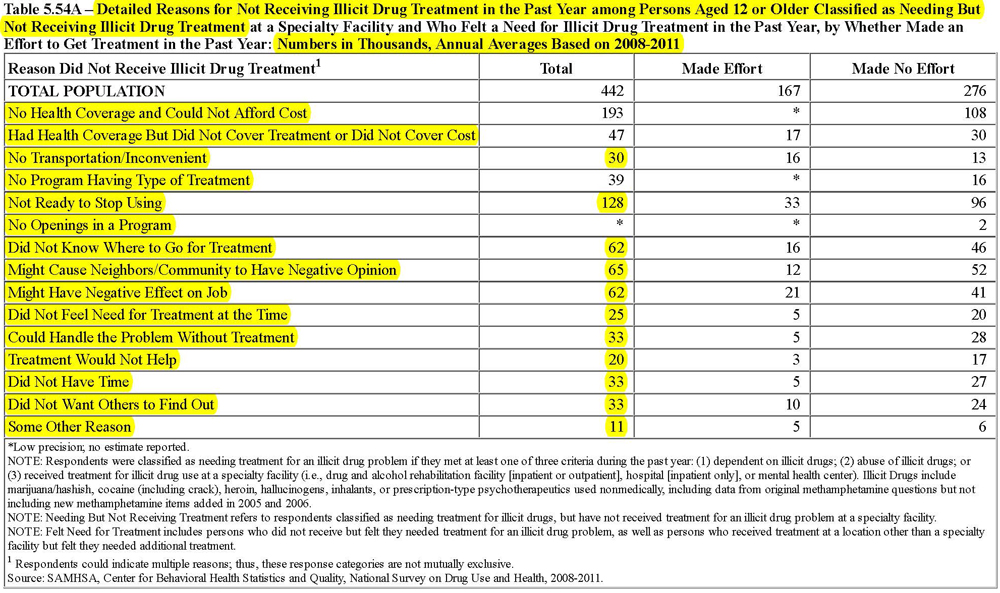
[7] Excuses Why Drug Users Don’t Get Treatment
A three year (2008-2011) U.S. government study (chart above) found that drug users provided their reasons why they did not get treatment. Almost half said they had no health insurance or could not afford health insurance. Somehow, they were able to afford drugs over 3 years however.
More than half were either in denial that they had a problem, thought they could take care of their drug problem(s) on their own, or were paranoid that others might find out. Keep in mind that this study was conducted by medical and research experts who concluded that the subjects were addicted to one or more drugs. Most states if not all have drug treatment programs paid by the taxpayers in the respective states.
[8] Mexico Legalized Most Drugs in 2006 for “Personal Use”
Drug proponents argue that legalization of drugs will somehow eliminate drug related crime. Even Secretary of State Hillary Clinton stated that she is “not convinced” that drug legalization would end violence (Source: Huffington Post PDF). One doesn’t have to look too far from the USA to see that legalization of drugs has not reduced crime.
In 2006, the Mexican federal government legalized many drugs for “personal use” in small amounts.
“Mexico’s Congress approved a bill Friday decriminalizing possession of small amounts of marijuana, ecstasy, cocaine and heroin for personal use…”
— Source: Fox News, 04-28-2006
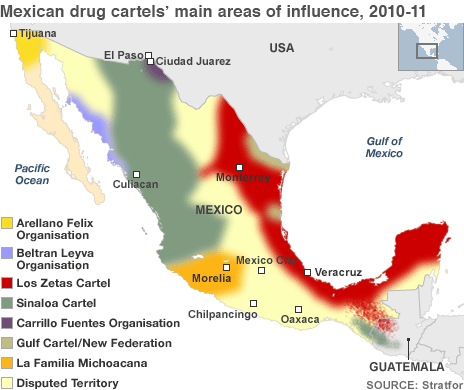
[9] Drug Violence Soaring Since Drug Legalization in Mexico
A striking correlation is that the gun violence and drug crimes in Mexico escalated every year since “small amounts” of drugs were legalized.
When drugs were first legalized in Mexico in December 2006, there were 62 deaths that month from drug-related violence. Just four years later, the number of people killed from drug-related violence has totaled 34,612.
Total number of victims in drug-related violence in Mexico, per year
- December 2006: 62
- 2007: 2,826
- 2008: 6,837
- 2009: 9,614
- 2010: 15,273
— Source: BBC News.UK, 01-14-2011
Some might argue that the problem is Mexico’s drug cartels. Mexico made it easier for drug cartels to keep producing with legalization. The U.S. has plenty of drug-related crimes, gangs, and drug organizations that operate all over the USA. They just don’t get the high publicity. One should note that the drug violence in Mexico got significantly worse AFTER the government legalized drugs for “personal use.”
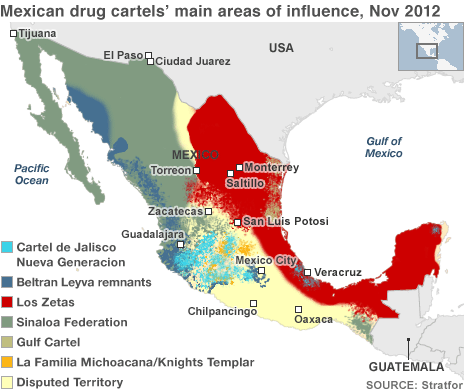
Between January and September 2011, the government of Mexico issued “partial figures” that said another 12,903 people were killed in drug-related violence. Since Mexico’s Presidente Felipe Calderon came to office, approximately 50,000 people have died during his six terms (Source: BBC News.UK). From 2006-2012 some 70,000 people have been killed in drug-related crimes in Mexico (Report, point 11).
“(Mexico’s) Attorney General Jesus Murillo said it was estimated that some 70,000 people had been killed since Mr Calderon launched a crackdown on the drug cartels in 2006. A further 9,000 were missing.”
— Source: BBC, 01-10-2013
The people of Mexico elected a new president, Enrique Peña Nieto who assumed office December 1, 2012. To view an interactive map timeline of the cartels in Mexico, see BBC graphics here.
All of the major drug cartels in Mexico produce the most common drugs sold in the USA – including cocaine and marijuana [Source: 2011 National Drug Threat Assessment (DOJ), p7 of 72pps) (PDF) (share link)]. With marijuana currently “legal” in two states and used for “medical purposes” in 16 other states this should be a big boost for the drug cartels.
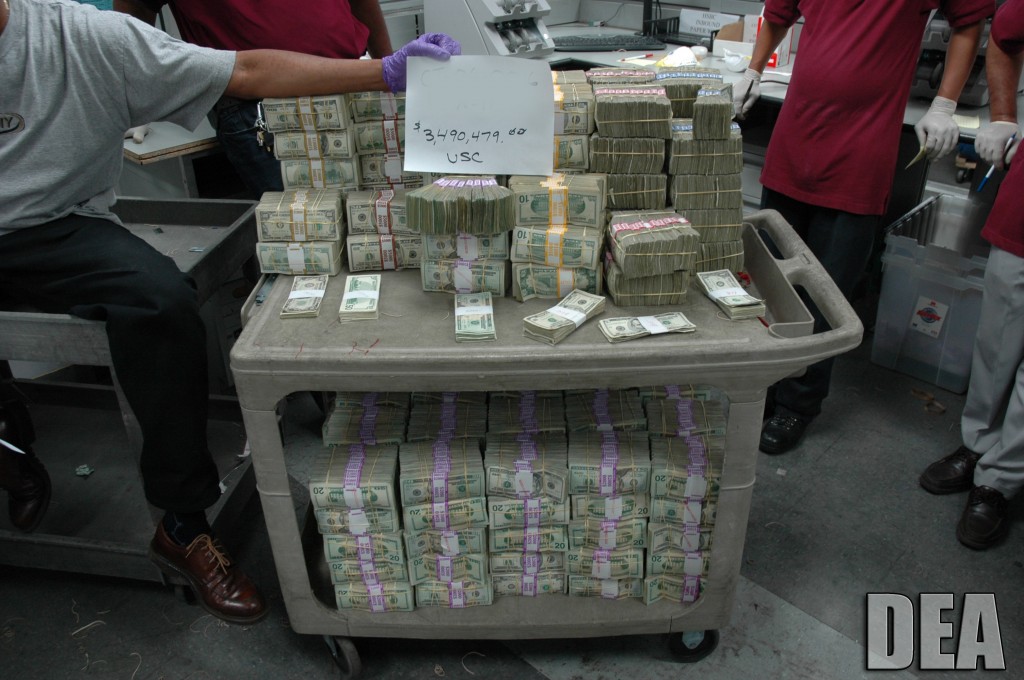
[10] Drug Money
In October 2009, federal and local law-enforcement seized $3.4 Million in cash from the sale of illegal drugs in the United States. This included nearly 730 pounds of methamphetamine, 62 kilograms of cocaine, 967 pounds of marijuana, 144 weapons, and two clandestine drug labs (Source: CS Monitor).
In all of 2009, the Arizona Department of Public Safety alone seized over $12 million in cash, 123,973 pounds of marijuana with a street value of $68,185,150, 1,094.5 lbs of cocaine, 366.8 lbs Methamphetamine, 44.6 lbs of Heroin, stolen vehicles and weapons (Source: AZ DPS).
These are just two of the countless incidents law-enforcement deals with on a regular basis. Guns and drugs go together. No law will stop criminals from obtaining firearms or drugs, and legalizing them in Mexico just hasn’t worked out too well.
[11] Did the Obama Administration Call the “War on Drugs” Over?
While doing research for this report, I came across the U.S. Department of Justice, National Archives website. According to the DOJ website they stated the following:
“NOTE: On June 15, 2012, the National Drug Intelligence Center will close. This
web site will no longer be maintained. The documents that are currently on this
site may contain dated information. They remain available to provide access to historical materials.”— Source: U.S. DOJ NDIC, (PDF, highlight added)
So we are not giving out any more information which short of National Security would be a violation of FOIA? Has the Administration given up on following intelligence information about drugs too? Or has the Administration effectively called the War on Drugs, (unofficially) over? This should be invested further.
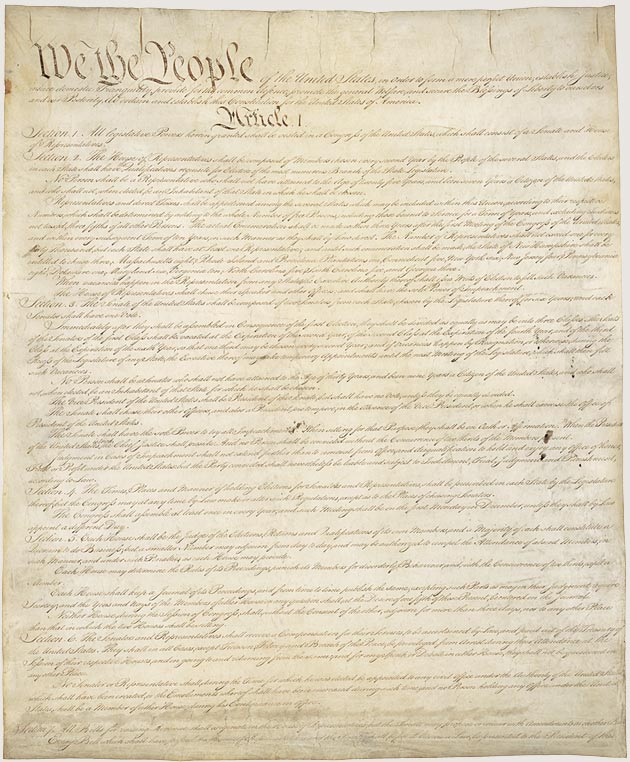
[12] WA & CO (“WA CO”) Attack on the U.S. Constitution
In November 2012, two U.S. states, Washington (WA), and Colorado (CO) together “WACO” passed legislation legalizing the drug marijuana. Denver, CO was also the first city “legalizing possession of less than an ounce of pot by individuals 21 and over” (Source: LA Times, 2005).
The Controlled Substances Act (CSA) passed by Congress in 1970 makes it illegal to “manufacture, importation, possession, use and distribution of certain substances” per 21 U.S.C. §801 et seq. Drug paraphernalia is also a crime under §863.
Under federal drug laws, marijuana (cannabis) is a “Schedule I Controlled Substance” (PDF). Other Schedule I drugs are heroin, lysergic acid diethylamide (LSD), peyote, methaqualone, and methylenedioxymethamphetamine (MDMA)(“Ecstasy”).
Washington and Colorado‘s passing a state law to legalize marijuana violates federal drug law(s). A state that passes a law that supersedes a federal law is unconstitutional.
[13] Obama Ignores Federal Drug Law & the U.S. Constitution
President Obama said he has no intention to enforce U.S. Federal drug laws with ‘recreational use’ for marijuana in Washington and Colorado:
“It does not make sense from a prioritization point of view for us to focus on recreational drug users in a state that has already said that under state law that’s legal.”
— Barack Obama (Source: Reuters).
So the rational here, according to the President seems to be – if a state passes a law, that will supersede any Federal law; and the President is OK with that?
President Obama – a lawyer, who apparently taught Constitutional law at the University of Chicago Law School from 1992-2004, asked Attorney General Eric Holder about how to deal with conflict of state laws and federal law?
“How do you reconcile a federal law that still says marijuana is a federal offense and state laws that say that it’s legal?”
— President Barack Obama [Source: ABC News, 12-14-2012 (HTML) (PDF)]
This is a really easy answer and one doesn’t have to be a Constitutional lawyer or law professor to know the answer to Mr. Obama’s legal query. It took almost 10 seconds on the Internet to figure out the law. The answer is — federal law supersedes state law —. This law is almost 200 years old and is part of the U.S. Constitution under the Supremacy Clause as follows:
“…this Constitution, and the laws of the United States, which shall be made in pursuance thereof,” “shall be the supreme law of the land,” and by requiring that the members of the State legislatures and the officers of the executive and judicial departments of the States shall take the oath of fidelity to it.
The Government of the United States, then, though limited in its powers, is supreme, and its laws, when made in pursuance of the Constitution, form the supreme law of the land, “anything in the Constitution or laws of any State to the contrary notwithstanding.”
— U.S. Constitution, Article IV, Section 2 (Supremacy Clause) (Source: Cornell Law School)
This law was written (arguably) so that states could not attack and individually amend the U.S. Constitution for the rest of the Union.
[14] U.S. Supreme Court Upheld Article IV Supremacy Clause in 1819
The state of Maryland attempted to pass a law that superseded federal law. The Maryland courts upheld the lower court rulings until the case went to the U.S. Supreme Court.
In re: McCulloch v. Maryland, 17 US 316 (1819), the U.S. Supreme Court ruled that “the Legislature of Maryland is contrary to the Constitution of the United States, and void…”
The High Court reversed all lower court rulings related to this case that effectively attempted to pass a law that would effectively gain power above the U.S. Constitution.
Colorado and Washington just did the exact same thing with legalizing marijuana in their states. Some might argue that (legalizing drugs) – in this case, marijuana is just a minor thing. Once an attack has been made upon the Supreme Law of the Land (U.S. Constitution), that begs the question: What else will they attempt to do?
Any attack on the U.S. Constitution threatens the very framework our Forefathers created for us 236 years ago. With a President turning the other way from this oath to uphold the Constitution, will Congress decide to hold their oath and enforce the laws they write?
Free Public Domain Images: Source: U.S. Government
U.S. Constitution 1 of 4 (link)
U.S. Constitution 2 of 4 (link)
U.S. Constitution 3 of 4 (link)
U.S. Constitution 4 of 4 (link)
Declaration if Independence (link image w/ text)
Bill of Rights (link) / Bill of Rights Transcript (PDF link)
Credits: Other Images/ graphics (not Constitutional related) may be copyright by their respective owner where noted.
original content copyright © 2012, revised 2014 NetAdvisor.org® All Rights Reserved.
NetAdvisor.org® is a non-profit organization providing public education and analysis primarily on the U.S. financial markets, personal finance and analysis with a transparent look into U.S. public policy. We also perform and report on financial investigations to help protect the public interest. Read More.

